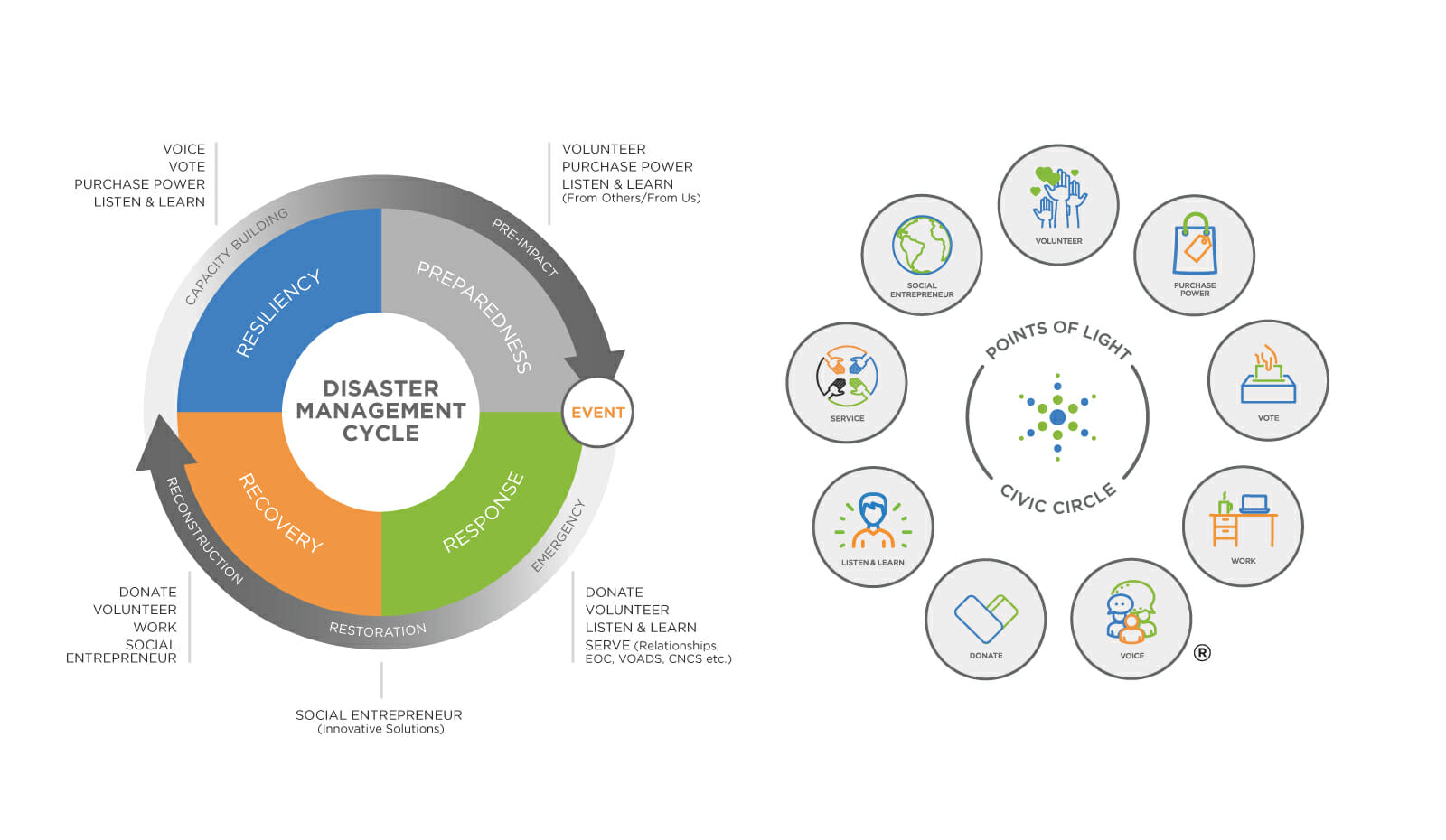How the Disaster Management Cycle and The Civic Circle® Can Drive Response and Recovery

This is the second in a blog series about National Preparedness Month. Read the last post to learn the four most important things you can do to support your community in a disaster.
Building resilience in communities worldwide is essential to responding to natural and human-made disasters. But what does that mean? Resilience in communities looks like the ability to resist, absorb, accommodate to and recover from the effects of disaster. Non-governmental Organizations (NGOs) around the world understand how to support communities and build their resilience. Today, more than ever, that role is essential.
“Disasters are becoming more frequent, they’re stronger and they’re more expensive,“ said Meghan Foley, a disaster preparedness and response expert with more than a decade of hands-on experience. “The government alone can’t handle the capacity of what’s needed. The nonprofit and NGO community are the trusted community members on the ground, and they know their people and they know their needs.”
Agnieszka Lissowska-Lewkowicz, president of Points of Light Global Network affiliate and Polish NGO Centrum Wolontariatu, agrees. When the Ukraine war began, the organization had a steep learning curve. Faced with the influx of what would ultimately become 1.5 million refugees crossing the border to safety, Agnieszka and her small staff began to learn the ins and outs of disaster response in real time.
“We never worked before on a disaster response. It was very difficult for us,” said Agnieszka. “The first period was very intense, making our everyday work almost impossible, but we quickly understood that long-term help is needed and the systematic approach.”
Nonprofits and NGOs are increasingly taking on the disaster management cycle as events increase in frequency and intensity. Because their life force stems from the volunteers who power their work and the communities they serve, facing disaster can become more manageable when community members think and act with intent.
Learning the Terms
What is the Disaster Management Cycle?
The Disaster Management Cycle is a framework that defines the stages of a disaster. It comprises four phases: resiliency, preparedness, response and recovery. Every community is in one of these four phases right now. The first and second, the “blue sky” phases, are critical planning opportunities. Actions taken during these times reduce the severity of impacts on a community and its people. The third and fourth phases, known as the “gray sky”, occur after a disaster. Depending on the extent of a disaster, a community can remain in recovery for a long time.
What is the Points of Light Civic Circle?
The Civic Circle helps people connect to opportunities and understand that doing good comes in many forms. It represents the power to lead, lend support and take action for causes you care about so that you can drive real and sustained change. Overlay the Civic Circle onto the Disaster Management Cycle, and it becomes clear when and how to take actions that support communities.
How Do The Disaster management cycle and the civic circle Work Together?
When you parse out the nine elements of the Civic Circle, you can start to see how they align with the four phases of the Disaster Management Cycle, no matter which phase of the cycle your community is in.
New Disaster Planning Guide from Points of Light and The Allstate Foundation
Prepare Now: Download the Disaster Planning Guide
Building Sustainable Communities: A Guide to Disaster and the Civic Circle, is a resource that offers insights and strategies to empower you to take action via the Civic Circle. Download the guide today made possible in partnership with The Allstate Foundation, and created by Points of Light.
Resiliency, one of the “blue sky” phases, is an excellent time to focus on using your voice to advocate for policies, resources, and infrastructure in your community. Advocate for those assets that help keep your community safe, such as a warning siren or restoration of the environment.
During preparedness, another one of the “blue sky” phases, consider volunteering with an organization that’s doing work that resonates with you, or serve your elderly neighbors by checking in with them and discuss their plans in the event of an emergency.
Once a disaster has happened and the community is in response mode, you might donate to a local organization doing response and recovery work in your community. Donating money is often the most useful resource for nonprofits and NGOs, and choosing a local outlet is the best way for your dollars to have the biggest impact. If you are thinking of donating items, like clothing or toiletries, it’s essential to do so at the right time and place. Otherwise, your act of goodwill may do unintentional harm. Follow the guidance of responders on the ground.
Volunteering may not be as straightforward as you imagine. The first rule of thumb is to never self-deploy. Although your intentions may be good, when you skip the step of working through a trusted organization, you may end up causing harm. Organizations responding to disaster are dealing with vulnerable people who are undergoing trauma, which is why volunteers working with these populations often must undergo background checks and complete specialized training. To be best positioned to serve when disaster comes, sign up with a trusted organization now.

Finally, the “gray sky” time of recovery can go on for a long time, so this is the phase where sustained efforts carry the most value. Support a social entrepreneur, or a person who has identified a need that has not been met by traditional institutions, structures and systems. These innovators often lead creative solutions that can support disaster response and recovery. Take Daily Point of Light Honoree 14-year-old William Cabaniss, who sold more than $45,000 in vanilla extract, donating the proceeds to Second Harvest Food Bank of East Tennessee.
As always, volunteering is the backbone of how nonprofits and NGOs deliver their missions to serve their communities. There is always a volunteer gap once media attention wanes, so consider how you can continue to support an 18 to 24-month-longprocess of rebuilding and recovery. Long-term recovery groups need help rebuilding homes, offering translation services, and providing pro bono legal and financial advice. Choosing an organization now that does work that resonates with you is a good way to ensure you’re trained and ready to help when disaster comes.
“We knew that for those Ukrainians who stayed we have to offer some long-term help,” said Agnieszka. “And that this help has to be wise, focused not on the basics needs but on social adaptation, work, education, psychological help. So, we needed specialists, cooperation between different organizations regarding their experience and funds.”
Centrum Wolontariatu shifted its focus to long-term recovery and assimilation, helping displaced Ukrainians to learn Polish, find jobs, get support in building new lives in Warsaw.
The organization’s learnings reflect what disaster preparedness experts know all too well. Responding to disaster requires a multi-pronged approach, both from the organizations responding and community members themselves. Disasters can often feel chaotic, but by understanding the cycle, you can feel empowered to take hold of each phase by taking action that builds resilience in your own community.
Our next post in this four-part series gives a behind-the-scenes look at disaster response and recovery. Plus, don’t miss our last post in this series to learn the four most important things you can do to support your community in a disaster.
